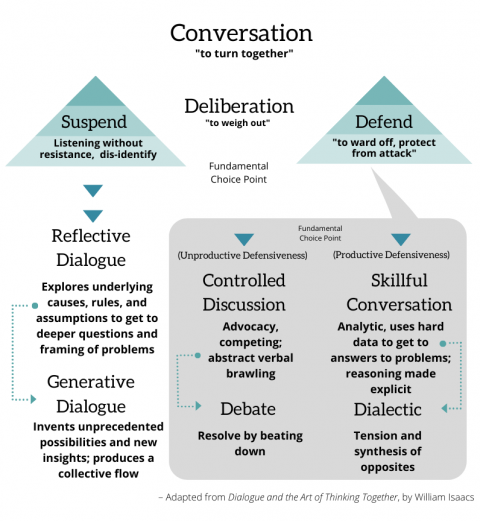Which pig do you see? - Thinking About Communication
The following is a summary of key learnings and resources from a virtual session held as part of the ArtsEngage Learning Community in mid-December, 2020. The focus of this session was Communication.
As we explore broad topics such as evaluation, participation, and communication, we always want to centre our conversations in the reason we are all here - art. This is particularly important for the topic of communication, as this quote reminds us:
"Art is the most effective mode of communication that exists." - John Dewey
The goal of this session was to explore communication in its broadest sense - how do we tell stories, and how do we listen to, understand, and reflect on the stories of others (whether this be through art or in our daily lives)?
We started the session with a quick warm-up, placing cohort members in pairs and inviting one person to share an experience, any experience, that still resonates with them. Partner A was invited to share for 3 minutes with no interjections from Partner B. The roles were then reversed with new partners. The goal here was to practice solely listening - without thinking about yourself, your reactions, or how you are going to respond. This exercise allowed us all to think about how we communicate, listen, and empathize with others.
Following this track, we then shared Hans Meller's concept of the pig as an illustration of multiple viewpoints. Imagine many different people are looking at a pig. The pig itself does not change, but each person sees it from a different viewpoint. For example, an artist might see a subject, a child might see a pet, a chef might see an ingredient, a wolf might see prey, and so on.
Finally, before moving to an open discussion, we looked at the following diagram and quote from Dialogue and the Art of Thinking Together, by William Isaacs.
"Dialogue... is a conversation with a centre, not sides" - William Isaacs, Dialogue and the Art of Thinking Together

Both quote and diagram are great reminders that Generative Dialogue, the kind of dialogue that is truly productive and leads to innovative solutions, requires genuine openness. Other approaches (even advocacy, which we in the arts tend to think of as positive and useful), lead to a debate of entrenched views, rather than true dialogue and change.
These warm-up prompts led to fascinating discussions with the participating artists and presenters. The group members reflected on communication practices in their own lives, and particularly in their arts work. A few key reflections included:
- Thinking intentionally about how we communicate can lead to real change. - For example, one artist shared how he has changed his practice in relation to teaching. While he used to approach his role as a teacher from a top-down approach ("It is my job to share my knowledge."), he know looks at it as one of sharing and growing together. He has started the practice of intentionally asking himself, outloud, before each class, "What am I going to learn today?"
- We can't assume that one form of communication will work for everyone. - Another artist who works often with the disability community shared how her perspectives have changed. While she used to assume that most people's communication needs/preferences are similar, since working with the disability community, she has realized that needs range greatly, and has started consciously asking, "What is the best mode of communication for you?"
- Even when we try to communicate clearly, we can't predict how a listener will interpret our communications. This is why, as presenters and artists, we need to be in constant dialogue with our communities. One-way communication will only lead to misunderstanding and exclusion.
- The group reflected on the opening warm-up activity, and the need to put intentional thought into listening and reflecting on what we hear before responding. It is surprising how often we fail to listen - instead assuming that we know what is best, or thinking of our response rather than hearing what the other person is communicating. One presenter shared her feeling that she has too often assumed what her audience might want or need, rather than asking them
"Sometimes we fight for what we think the answer should be, and that makes us totally oblivious to the answer that is emerging in the moment... the new truth of the moment."
- In our fast-paced society, we also fail to put aside time to reflect, a practice that is useful in all of our daily lives (particularly when we jump from one Zoom meeting to the next), but is especially important in any community engagement project.
- The presenters in the group shared their changing perspective on dialogue, storytelling, and community. Too often we think of the audience in terms of numbers, but they are a distinct group of people, all with individual stories and perspectives. Each audience member will have different artistic interests and will relate differently to each performance. Rather than thinking about numbers, how can we give ourselves the freedom to think about our programs like a dinner party? When you host a dinner party, it's not about how many people are in the room, and it's about having the right people in the room, creating an experience together.

 rtraction
rtraction